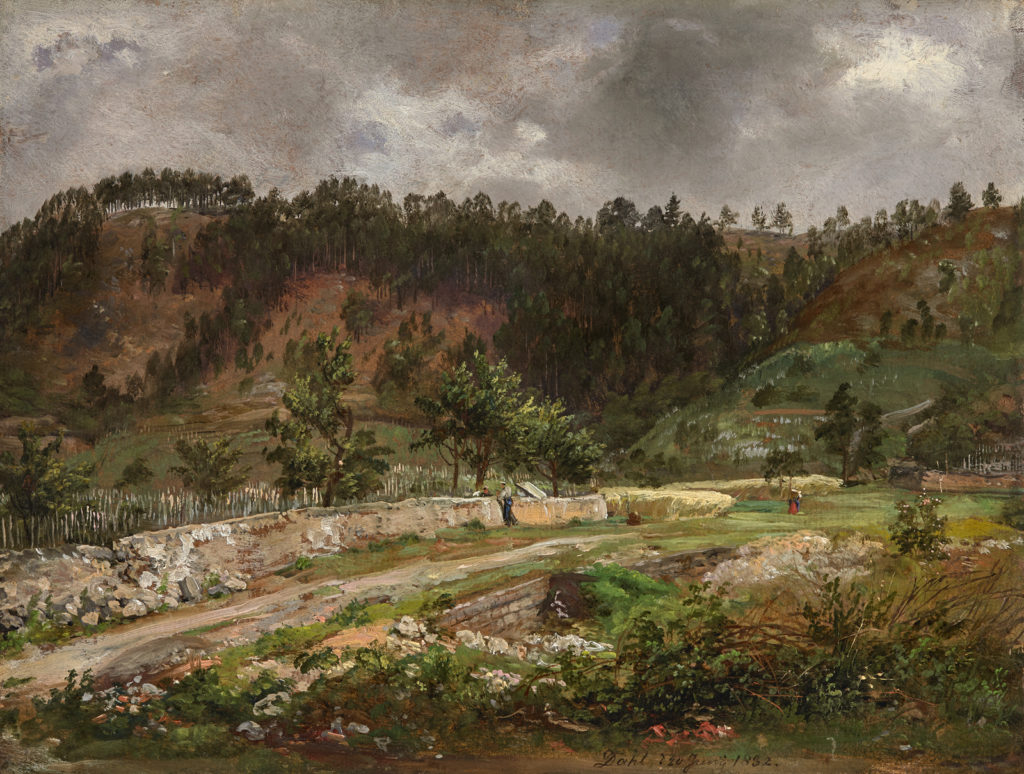Johan Christian Clausen Dahl (Bergen 1788 - 1857 Dresden)
A Country Road near Pillnitz, June 1832
Oil on paper laid down on canvas, 20.5 x 27.4 cm
Signed lower right JDahl d 20 Juny 1832.
Provenance:
Georg Jacob Bull [1] (1785-1854) (jurist and politician, father of Anders Sandøe Ørsted Bull, the husband of Dahl’s daughter Caroline Bull)
Dr. Edvard Isak Hambro Bull (1845-1925, physician, grandson of Georg Jacob Bull)
Prof. Francis Bull (1887-1974) (Norwegian literary historian, son of Edvard Isak Hambro Bull)
Blomqvist Kunsthandel, Oslo 1926
Grev Wedels Plass Auksjoner, Oslo, auction 24 May 2005, lot 89
Private collection, Norway
Lempertz, Cologne, auction 11 May 2013, lot 1208
Private collection, Canada
Literature:
Andreas Aubert, Maleren Johan Christian Dahl: et stykke av forrige aarhundredes kunst- og kulturhistorie, Kristiana 1920, p. 454 (Naturstudie Pillnitz)
Johan H. Langaard, J.C. Dahl’s verk, Oslo, 1937, no. 381
Marie Lødrup Bang, Johan Christian Dahl 1788-1857. Life and Works, vol. 2, Oslo 1987, p. 226, no. 694
Johan Christian Clausen Dahl repeatedly depicted motifs taken from the varied landscape of his adoptive home town of Dresden: the Große Garten, the high, sloping banks of the River Elbe, the valley of the Plauenscher Grund, and the hilly area south-east of Dresden known as Saxon Switzerland – to mention but a few. The resulting oil studies are delightful and very personal impressions of nature, which capture not only the topography but also the prevailing light conditions and time of day.
After completing his studies at the Academy of Fine Arts in Copenhagen, Dahl embarked on a Grand Tour in the summer of 1818. That autumn he stopped in Dresden, where he became acquainted with Caspar David Friedrich. Following his tour of Italy, which he undertook in 1820, he settled permanently in Dresden in 1821. From 1823 onwards, he shared a house with Caspar David Friedrich that offered a magnificent view of the River Elbe.
Together with Friedrich and Carl Gustav Carus, Dahl was the most important Dresden artist of the epoch and exerted a formative influence on German Romantic painting.[2]
Starting in the spring of 1832, Carus’s new country house, situated not far from Pillnitz Castle on the bank of the River Elbe, became a social meeting place, frequented by such painters as Friedrich, Dahl, Eduard Bendemann and Julius Hübner. These artists took advantage of their stays there by exploring nature and making close observations of their surroundings,[3] one result of which is Dahl’s present oil study, dated 20 June 1832.[4]
Clouds gather above the slopes of the River Elbe to create an overcast sky. A crop of grain grows in the field, next to which one sees, in a walled-in vineyard, the wooden poles that will soon support the grape vines. Country folk have set out to work in the field and the vineyard. The road, lined by a stone wall, runs diagonally through the pictorial space, creating perspectival depth. Dahl’s rendering of the peculiar light just before a summer thunderstorm breaks is indeed impressive.
Dahl’s painting reflects his keen interest in natural phenomena – especially cloud formations – observed from life.[5] In a fruitful discourse on this subject, he sided with his painter friend Carus, who, in his Neun Briefe über Landschaftsmalerei (Nine Letters on Landscape Painting), a book on painting theory, urges artists to study the intrinsic laws of atmospheric phenomena, the diverse nature of clouds, their accumulation, movement and dispersal. Both painters certainly knew the pioneering cloud theories formulated in 1802 by the Englishman Luke Howard in his publication On the Modification of Clouds.[6]
[1] For articles on individual members of the Bull family, see Store norske leksikon https://nbl.snl.no/ (7 July 2016). [2] Hans-Joachim Neidhardt, 'Johan Christian Dahl – ein norwegischer Maler in Dresden', in Johan Christian Dahl 1788-1857. Ein Malerfreund Caspar David Friedrich, exhib. cat. Munich, Neue Pinakothek, Munich 1988, pp. 15-19. [3] Cf. Carl Gustav Carus. Natur und Idee, exhib. cat. Staatliche Kunstsammlungen Dresden and Staatliche Museen zu Berlin, vol. 2, Dresden and Berlin 2009, pp. 72-73. [4] Two more studies produced in the following two days, View near Pillnitz (Bang 695) and Region near Pillnitz (Bang 696), also survive. [5] Cf. Wolken Wogen Wehmut: Johan Christian Dahl, Munich, Haus der Kunst and Schleswig, Stiftung Schleswig-Holsteinisches Landesmuseum Schloss Gottorf, Cologne 2002, pp. 42-44. [6] Goethe reported this in an essay of 1820. Goethe himself introduced Dahl’s friend, the physician, scientist and artist C.G. Carus, to the subject. Andreas Aubert – who published two authoritative works on Dahl – records that Goethe lent Dahl a copy of Luke Howard’s key work, On the Modification of Clouds.

